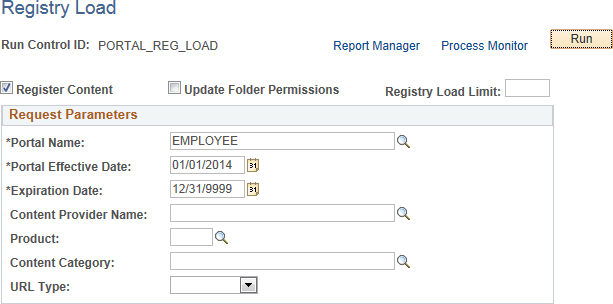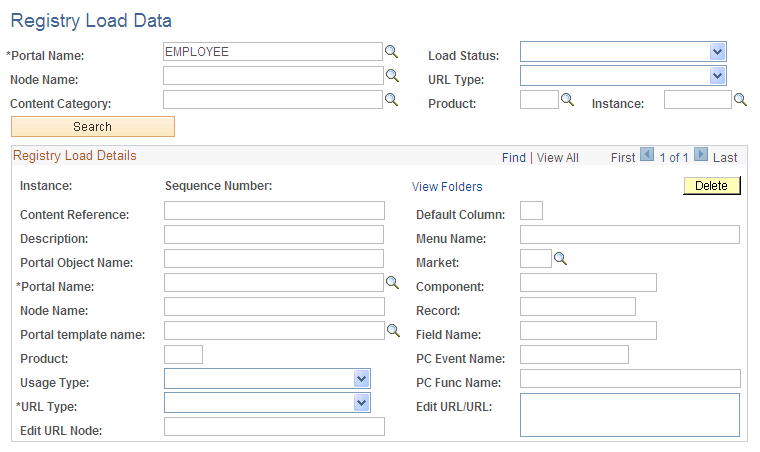Running the Registry Load Process
This topic discusses running the Registry Load process and review and correct errors.
Note: The user running the Registry Load process should have the role of PeopleSoft Administrator. This will ensure that they have the necessary security to successfully load any and all content references.
|
Page Name |
Definition Name |
Usage |
|---|---|---|
|
EO_PE_RUN_LOAD |
Run the Registry Load process. |
|
|
EO_PE_REG_LOAD |
Review and correct loaded data or errors. |
|
|
Registry Load Folders Page |
EO_PE_FLDR_SEC |
View the folder hierarchy for the folders that were created by the Registry Load process. |
Use the Run Registry Load page (EO_PE_RUN_LOAD) to run the Registry Load process.
Navigation:
This example illustrates the fields and controls on the Registry Load page.

To run the Registry Load process:
Select the Register Content option.
Deselect the Update Folder Permissions option to skip updating the parent folders with their children's content reference permission lists.
Updating the folder permissions can be done at any time. The Registry Load process uses the portal registry data to update the folder permissions for the entire portal registry. It does not use the data in the staging tables.
Leave the Registry Load Limit field clear or enter 1000 to limit the number of rows that are loaded.
Select the portal registry that matches your staged registry data in the Portal Name field.
The default portal definition is EMPLOYEE.
Enter an effective date.
Enter an expiration date.
Click Run.
After the process runs, view and correct errors to the data in the staging tables using the Registry Load Data page. Rerun the process as needed.
See the product documentation for PeopleTools: Portal Technology.
Use the Registry Load Data page (EO_PE_REG_LOAD) to review and correct loaded data or errors.
Navigation:
This example illustrates the fields and controls on the Registry Load Data page. You can find definitions for the fields and controls later on this page.

Field or Control |
Description |
|---|---|
Portal Name |
Enter the portal name that was specified when you ran the process. |
Load Status |
Select the load status of the rows that you want to view. Values are: Error in Load Data: Content references were marked in error during the load process and were not registered. Not Registered: The load process did not pick up the content references. For rows that were processed but have a Not Registered status, check to see if the content references object name already exists in the portal registry. Successfully Registered: Load data was successfully entered into the portal registry. Leave this field clear to view all rows of the staging tables, including those rows that have not been processed. |
Search |
Click to retrieve applicable registry load data to the page. |
View Folders |
Click to access the Registry Load Folders page, where you can view the folder hierarchy. The page displays the folder created as well as the folder reference. |
Registry Load Details
Field or Control |
Description |
|---|---|
Error Detail |
Click for rows that are returned with the load status criteria set to Error in Load Data. A message box displays to provide you with the data that prevented the data row from being registered. Types of errors include:
|